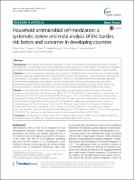| dc.identifier.citation | Ocan, M., Obuku, E. A., Bwanga, F., Akena, D., Richard, S., Ogwal-Okeng, J., & Obua, C. (2015). Household antimicrobial self-medication: a systematic review and meta-analysis of the burden, risk factors and outcomes in developing countries. BMC public health, 15(1), 742. | en_US |
| dc.description.abstract | Background: Antimicrobial self-medication is common in most low and middle income countries (LMICs). However
there has been no systematic review on non-prescription antimicrobial use in these settings. This review thus intended
to establish the burden, risk factors and effects of antimicrobial self-medication in Low and Middle Income Countries.
Methods: In 2012, we registered a systematic review protocol in PROSPERO (CRD42012002508). We searched PubMed,
Medline, Scopus, and Embase databases using the following terms; “self-medication”, “non-prescription”, ‘self-treatment’,
“antimicrobial”, “antimalarial”, “antibiotic”, “antibacterial” “2002-2012” and combining them using Boolean operators.
We performed independent and duplicate screening and abstraction of study administrative data, prevalence,
determinants, type of antimicrobial agent, source, disease conditions, inappropriate use, drug adverse events and
clinical outcomes of antibiotic self-medication where possible. We performed a Random Effects Meta-analysis.
Results: A total of thirty four (34) studies involving 31,340 participants were included in the review. The overall
prevalence of antimicrobial self-medication was 38.8 % (95 % CI: 29.5-48.1). Most studies assessed non-prescription use
of antibacterial (17/34: 50 %) and antimalarial (5/34: 14.7 %) agents. The common disease symptoms managed were,
respiratory (50 %), fever (47 %) and gastrointestinal (45 %). The major sources of antimicrobials included, pharmacies
(65.5 %), leftover drugs (50 %) and drug shops (37.5 %). Twelve (12) studies reported inappropriate drug use; not
completing dose (6/12) and sharing of medicines (4/12). The main determinants of antimicrobial self-medication
include, level of education, age, gender, past successful use, severity of illness and income. Reported negative
outcomes of antimicrobial self-medication included, allergies (2/34: 5.9 %), lack of cure (4/34: 11.8 %) and causing death
(2/34: 5.9 %). The commonly reported positive outcome was recovery from illness (4/34: 11.8 %).
Conclusion: The prevalence of antimicrobial self-medication is high and varies in different communities as well as by
social determinants of health and is frequently associated with inappropriate drug use | en_US |

